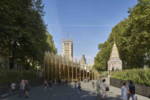Lambeth Pier
Buildings and structures in the London Borough of LambethPiers in LondonUse British English from December 2016

Lambeth Pier is a pier on the Albert Embankment, near Lambeth Bridge, on the south side of the Thames in London, England. It has been part of a ferry service up to the mid-18th century, and now serves pleasure rides and cruises along the river.
Excerpt from the Wikipedia article Lambeth Pier (License: CC BY-SA 3.0, Authors, Images).Lambeth Pier
Lambeth Palace Road, London Lambeth (London Borough of Lambeth)
Geographical coordinates (GPS) Address External links Nearby Places Show on map
Geographical coordinates (GPS)
| Latitude | Longitude |
|---|---|
| N 51.4949127 ° | E -0.1219824 ° |
Address
Lambeth Pier
Lambeth Palace Road
SE1 7SG London, Lambeth (London Borough of Lambeth)
England, United Kingdom
Open on Google Maps







